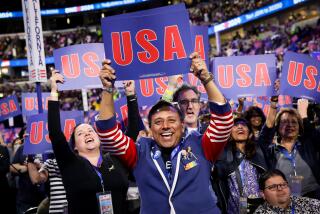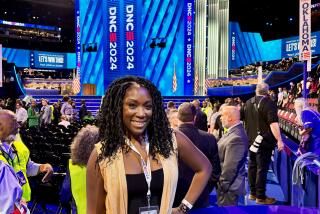1988 REPUBLICAN NATIONAL CONVENTION : Oversize Hall, Bad Acoustics : Production Trouble Plagues Convention
- Share via
NEW ORLEANS — On his way to New Orleans for the platform proceedings last week, George Bush was asked if he was concerned whether his nominating convention could fill the giant Superdome.
Not really, Bush said, and in any event he said he had been assured the sound system was state of the art. But then, betraying there were worries, indeed, he jokingly imitated an echo: “FOURTH DOWN! Fourth Down! Fourth Down. fourth down.”
The Republicans here have toiled mightily to stage-manage the convention in this football palace, but now at the half-time break, some of the vice president’s worst fears have come true.
In parts of the great hall, the echo has proven so severe that delegates can barely hear what speakers are saying. The networks get their sound through direct electronic cable, so television has not been affected.
Camera positions are less advantageous than during the Democratic convention, network professionals say. And the Reagan video was so loud on Monday night that when the President spoke afterward he seemed diminutive in person.
Goldwater’s Complaints
“This is the worst convention I’ve been to,” said former Arizona Sen. Barry Goldwater, who is attending his ninth. He was sitting in the Bush family box for the President’s address, but “I couldn’t hear a word of the speech,” Goldwater told NBC in a televised interview.
Nominating conventions are now virtually four-day television commercials--the equivalent of $40 million in advertising money if the party tried to buy eight hours of network prime time, according to Republican strategist Lance Tarrance.
And in this media age, technical mistakes have political consequences: When the balloons failed to fall from the ceiling for the Democrats in 1980, it became a metaphor for Jimmy Carter’s presidency.
The daunting technical issue here was mastering the hall, one so large that seven Omni auditoriums, where the Democrats held their convention in Atlanta, would fit inside.
The Republican solution was to shrink the Superdome into a room fit for a camera close-up.
Massive Curtain
The GOP draped a curtain 30 yards high and 100 yards long to cut the room in half. Then lighting director Carl Vitelli Jr. created the illusion that the ceiling was 40 feet high, not 300, by suspending an erector-set-like lighting grid 40 feet off the floor.
Vitelli also installed 1,800 lights--1.75 million watts of power--each one controlled by a separate dimmer, enabling the cameras to shoot every corner of the hall without shadows.
The design allows for 24 distinct looks, and each moment is carefully plotted. When Reagan spoke, for instance, “he was brightly lit with highlights on his shoulders and the back of his head, not too bright, because that washes him out and makes him look like an 80-year-old man, or however old he is,” said one of the lighting officials privately.
“It’s not a hockey game,” said lighting controller John Lawson. “The object is to make these guys look flattering.”
A Cyclorama background lighting machine allows Vitelli and producer Mark Goode to make the blue curtain behind the podium virtually whatever color on television fits best with each speaker.
‘Acoustical Disaster Area’
But the biggest challenge, and so far biggest problem, is sound. “It’s an acoustical disaster area,” said Stanley Miller, a Los Angeles sound consultant who has worked for the Republicans since the Nixon era.
Miller hung 15 tons of speakers 90 feet above the Superdome floor, powered by 720,000 watts, each speaker time-delayed so the sound would move through the vast arena at the proper pace.
Even the orchestra, which is 150 feet from the podium, had to have special microphones to accommodate for travel time of sound, or the echo effect would make it impossible to accompany a singer on the podium.
Yet with half the convention over, Miller and company are still tinkering to get it right. “Spaces that I thought wouldn’t be a problem were a problem,” he admitted. “It’s horrible.”
The producers have endeavored to give the impression that this is not a made-for-television convention. “We are doing everything to make this a real event, which TV is looking in on,” Miller said. “We didn’t take a TV approach.”
Like Show Business
But these days one business is like show business--it is politics. And Vitelli, who also does the Miss Universe and Miss America pageants, and Goode, who pioneered the confetti cannon lit by strobe lights, know it--no matter how much they pretend otherwise.
“Carl has designed (the lights) for the cameras, not the people out there on the floor,” said lighting controller Lawson.
A quick trip to the floor, indeed, and one discovers that the delegates must squint because those 1,800 bulbs point right at them, and VIPs in the sky boxes must watch the proceedings through the lighting grid.
Staff writer John Balzar contributed to this story.
More to Read
Get the L.A. Times Politics newsletter
Deeply reported insights into legislation, politics and policy from Sacramento, Washington and beyond. In your inbox twice per week.
You may occasionally receive promotional content from the Los Angeles Times.










